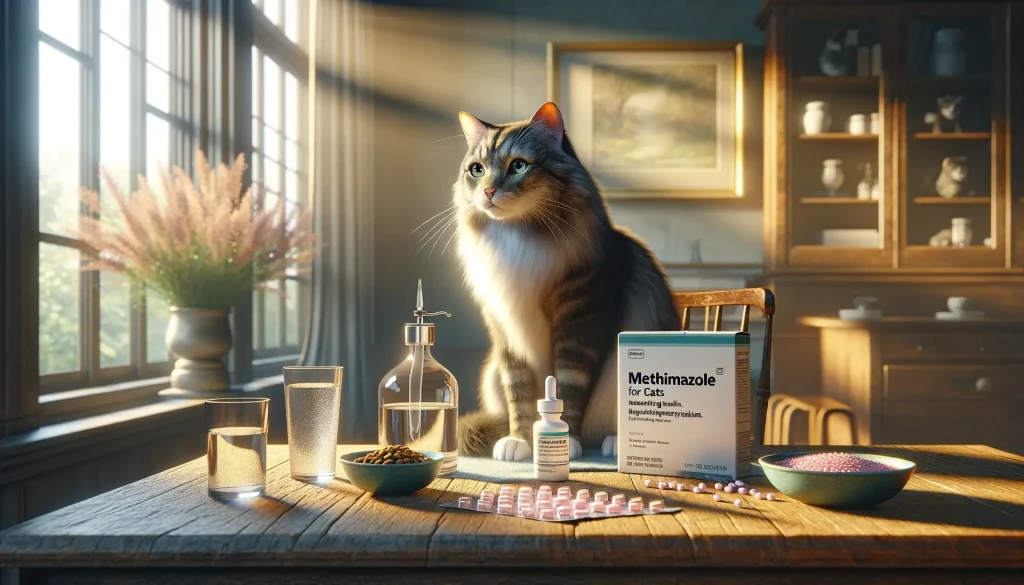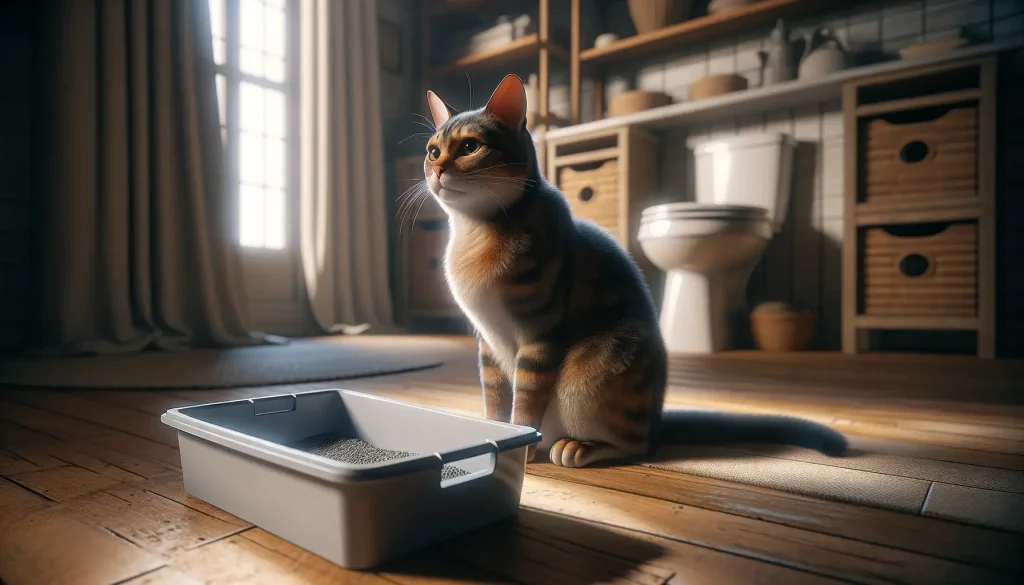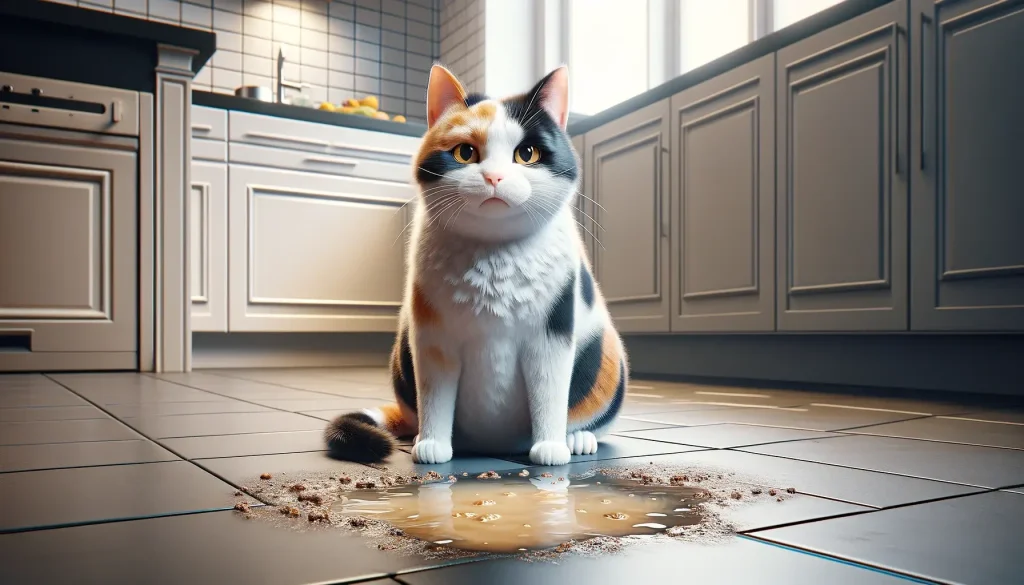
Know About Your Cat’s Upset Stomach and Vomiting
Vomiting in cats could be due to various reasons such as hairballs, dietary indiscretion, ingestion of foreign bodies or toxins, parasites, food allergies, inflammatory bowel disease (IBD), kidney disease, diabetes, liver disease, neurological conditions, and infections like feline infectious peritonitis (FIP). In some cases, it might even signal the presence of cancer, such as lymphoma. The nature of the vomit—whether it’s clear liquid, contains food remnants, green bile, blood, white foam, or even worms—can offer valuable clues about the underlying issue.
- Clear vomit might indicate an excessive intake of water, or it could point to kidney disease or diabetes.
- Vomit with food remnants may be due to overeating or food allergies.
- Green bile in the vomit suggests content from the small intestine.
- A presence of mucus might indicate a regurgitation issue.
- Red or bloody vomit is a sign that requires immediate veterinary attention, as it could denote ulceration or bleeding disordersWhite foam usually occurs when a cat is vomiting on an empty stomach.
- Vomit that includes worms clearly indicates a need for deworming.
But when should you start worrying about your cat’s vomiting? Occasional vomiting might not be a cause for alarm, but repeated episodes, signs of distress, blood in the vomit, or symptoms like lethargy, appetite loss, or dehydration necessitate a vet consultation. Getting to the root of the issue often involves a variety of tests such as blood work, X-rays, ultrasound, or endoscopy.
The question then arises: When is it just a hairball, and when is it something more?
Cat Regurgitation vs. Vomiting
Do you know the difference between your cat regurgitating and vomiting? It’s crucial to identify because it affects how you respond.
Regurgitation usually happens shortly after eating. It is often food that comes back up, looking much the same as when it was swallowed. This can be due to eating too fast or a more serious condition like esophageal disorders. Vomiting, however, involves more body effort and occurs later. It suggests a deeper issue in the digestive tract or beyond, maybe from the conditions mentioned before like kidney disease or diabetes.
| Sign | Regurgitation | Vomiting |
|---|---|---|
| Timing | Soon after eating | Can be anytime |
| Appearance | Undigested food | Digested food or bile |
| Effort | Little to none | Noticeable abdominal effort |
| Common Causes | Fast eating, esophageal issues | Hairballs, diseases, toxins |
While occasional vomiting might not be a major concern, regurgitation is often overlooked but can indicate an esophageal disorder or a blockage. This requires your attention and a visit to the vet.
Keep an eye on whether your cat is vomiting or regurgitating. This distinction helps you provide the right care. If your cat shows signs of distress, blood in their vomit, or symptoms like lethargy, it’s time to consult a vet. Remember, frequent regurgitation, just like vomiting, is not normal and warrants a professional check-up.
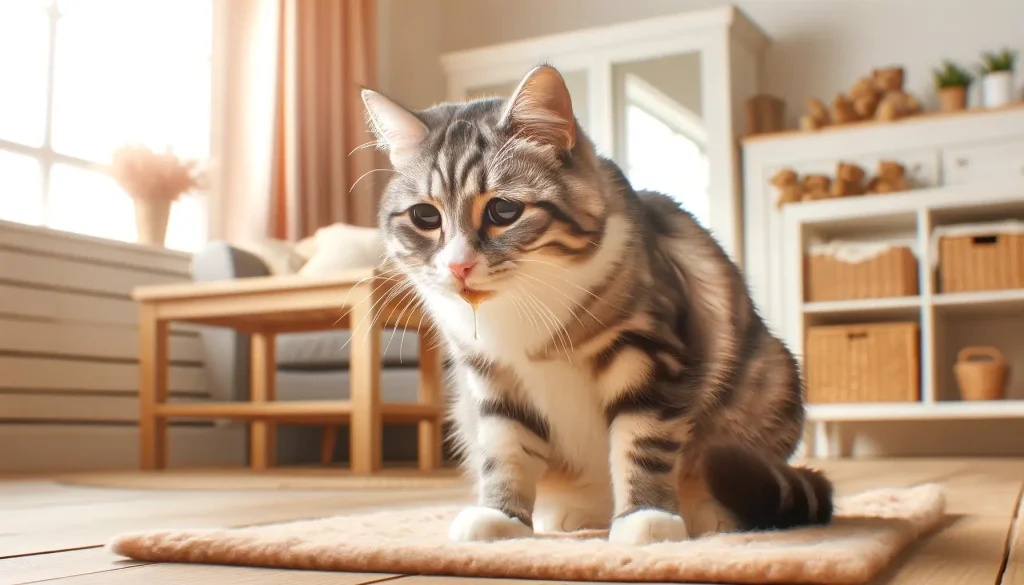
Managing Food Sensitivities in Cats
Cats, like humans, can experience food sensitivities or allergies that lead to digestive discomfort and vomiting. Recognizing and managing these sensitivities is crucial for maintaining your cat’s health and happiness. Here’s how you can address and prevent these issues.
Firstly, identifying the culprit in your cat’s diet is key. Food sensitivities often manifest as gastrointestinal upset, skin irritation, or both. If you suspect your cat has a food sensitivity, consult with your veterinarian about starting an elimination diet. This involves feeding your cat a simplified diet of proteins and carbohydrates they have never eaten before, then gradually reintroducing foods to pinpoint the allergen.
Once a food sensitivity is identified, choosing the right diet becomes paramount. There are numerous commercial diets formulated for cats with food sensitivities; these typically feature novel proteins (like duck, venison, or rabbit) or hydrolyzed proteins, where the protein is broken down into smaller pieces to avoid triggering an immune response. Always choose a high-quality, balanced diet to ensure your cat gets all the necessary nutrients.
Supplementing your cat’s diet with omega-3 fatty acids can also benefit cats with food sensitivities. Omega-3s, found in fish oil supplements, can help reduce inflammation and support skin health, which is especially helpful for cats experiencing dermatological issues alongside gastrointestinal symptoms.
Regular veterinary check-ups are crucial for cats with food sensitivities. These appointments allow for monitoring your cat’s response to dietary changes and ensuring their nutritional needs are met. Your vet can also recommend specialized tests or treatments if your cat’s condition doesn’t improve with dietary adjustments alone.
Finally, patience and observation are essential. Managing food sensitivities in cats requires a meticulous approach to diet and a keen eye for changes in your cat’s health. Documenting what your cat eats and how they respond can provide valuable insights for you and your vet.

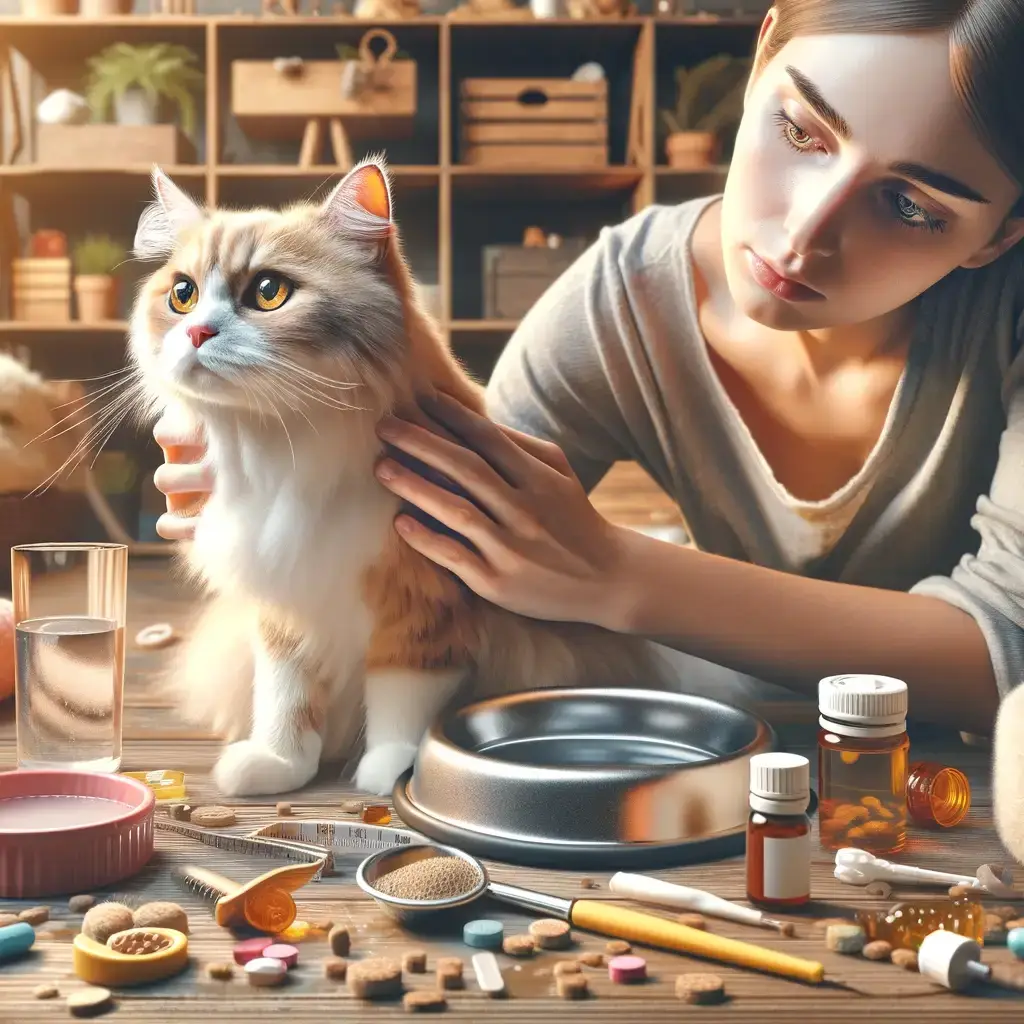
At Home Care and When to Call the Vet
When your cat starts vomiting, you might ask yourself, “Can I handle this at home, or is it time to see the vet?” Knowing what you can do and when to seek professional help is vital in ensuring the well-being of your furry friend.
At Home:
- Monitor eating habits. Make sure your cat is not eating too fast or consuming something they shouldn’t.
- Keep an eye on the frequency of vomiting. Occasional vomiting might not be a concern.
- Check the vomit for hairballs or food remnants. These are usually less worrying causes.
- Ensure your cat stays hydrated. Offer small amounts of water frequently if they are vomiting.
These steps can be helpful for minor issues. However, certain situations require professional advice.
When to Call the Vet:
- If the vomit contains blood, green bile, or worms, these are red flags that need immediate attention.
- A cat that vomits repeatedly, especially with signs of distress, lethargy, or appetite loss, could be facing a serious health issue.
- Dehydration is a risk with vomiting. Signs include a dry mouth, lethargy, and sunken eyes.
- If there’s a possibility your cat ingested foreign objects or toxins, do not wait. See the vet.
Vomiting can be a symptom of many conditions, from benign (like hairballs) to serious (such as cardiomyopathies). An occasional episode might not be alarming, but repeated vomiting, especially with concerning symptoms, requires a vet’s evaluation. They might perform tests such as blood work, X-rays, or ultrasound to find the root cause. Remember, it’s always better to err on the side of caution when it comes to your cat’s health.
Home care can manage some vomiting incidents, but always watch for signs that indicate a need for professional help. Your quick reaction could make a significant difference in your cat’s health outcomes.
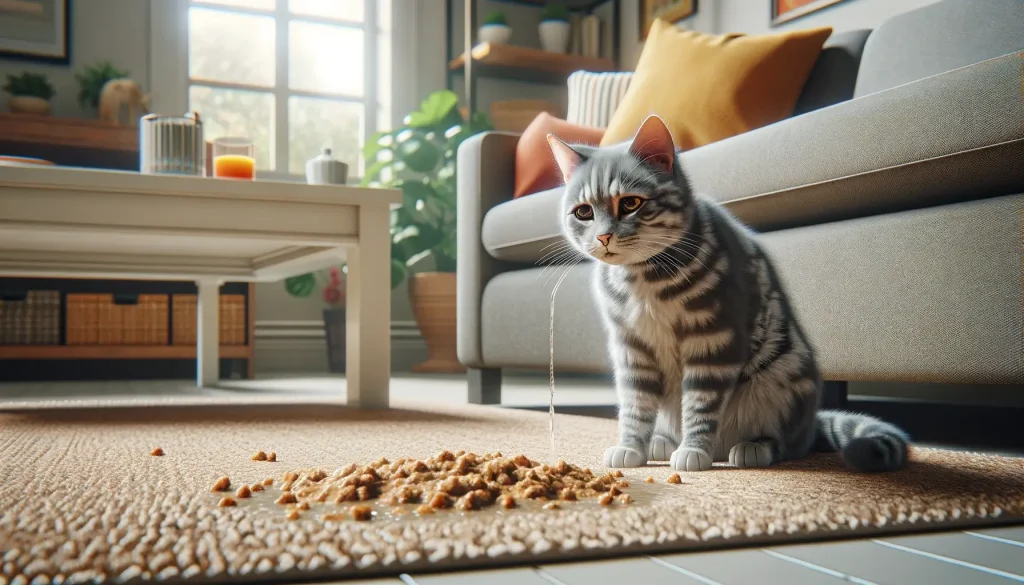
Preventing Cat Vomiting
Worried about your cat’s vomiting? While it’s not always preventable, there are steps to reduce the risk.
- Start with a quality diet. Food that matches your cat’s age, health, and lifestyle can prevent dietary issues.
- Avoid sudden changes in diet. Slow transitions help the digestive system adjust.
- For fast eaters, consider a slow-feed bowl. It helps prevent eating too quickly, a common cause of vomiting.
- Regular grooming reduces hairballs. Especially for long-haired breeds, grooming helps swallow less hair during self-cleaning.
- Keep toxins and small objects away. Cats are curious; ensuring they can’t ingest harmful items is crucial.
- Regular vet check-ups catch early signs of diseases that can lead to vomiting. Watch for parasites. Deworming and flea control are vital in preventing related vomiting.
Beginner Guide to Raising Quail at Home
What are the Signs of a Dog Concussion?
What Causes Your Dog’s Ears to Smell Bad?
When your dog’s ears start to emit an unpleasant odor, it might leave you puzzled…
Methimazole Treatment for Cat Hyperthyroidism
Methimazole plays a crucial role in managing feline hyperthyroidism, a condition marked by an overactive…
Got Hummingbirds in your Backyard? Here’s How to Care for Them.
Why Does Your Cat Pee Outside the Litter Box?
Cat’s Litter Box Issues It’s not uncommon for cat owners to face the frustrating dilemma…



